The Seagate 600 Pro SSD is a 2.5-inch MLC NAND enterprise-class SSD in a 7mm form factor with a capacity up to 480GB that is designed for read-intensive applications. Due to its size, the 600 Pro easily fits almost any platform, maximizing capacity while minimizing its footprint. Seagate’s primary focus during the engineering of this drive though was to build a drive to meet the growing demand within the enterprise for SSDs that offer enterprise-class endurance and adequate performance at a reasonable price-point. Organizations that need these types of drives include data centers, cloud system builders, cloud service providers or virtualized enterprises. In these applications, the enterprise requires more endurance than they could get with a client SSD; it wants a drive upon which it can depend to be reliable over time, thus keeping data secure.
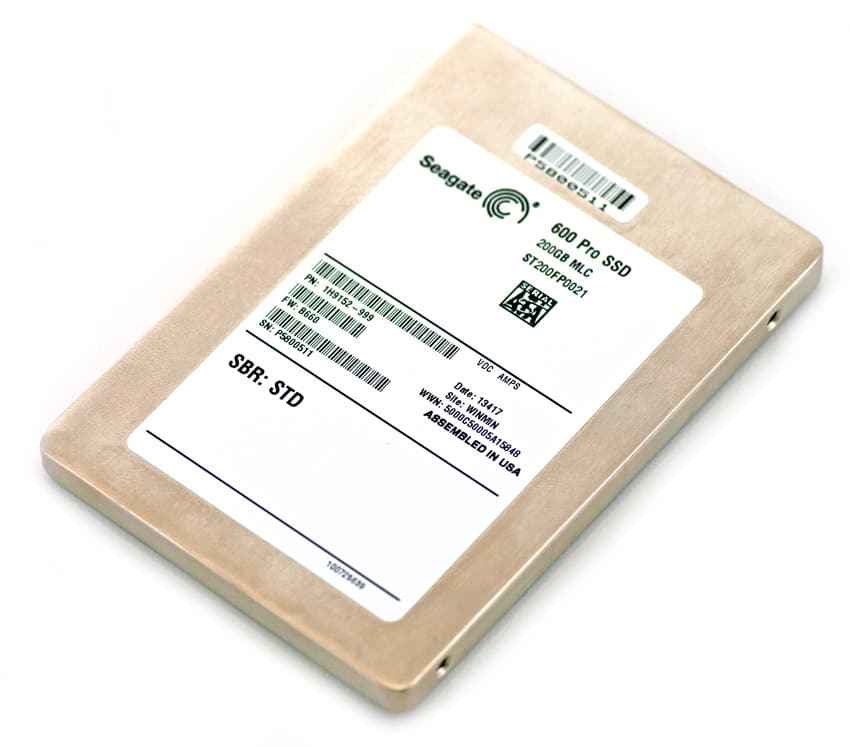
With the Seagate 600 Pro SSD, Seagate is delivering features to meet these needs. On top of the slim form-factor and capacity up to 480GB, the drive also offers a low-power consumption, high-IOPS design that is significant in achieving solid performance while still providing energy savings and a low TCO. Seagate rates the 600 Pro at 2.8W during average operation and a meager 0.5W during sleep mode. Additionally, Seagate brings the 600 Pro to market with six capacity offerings. This model isn’t overkill; three of the six options are more heavily over-provisioned at 22% (versus 6%) to yield far greater endurance for organizations that anticipate writing significantly more data to the drive over the lifetime of the 5 year warranty period.
Between the 600 client SSD and the 600 Pro, there are essentially three major divergences when it comes to design. First, while the client drive comes in 120, 240 and 480GB capacities, the Seagate 600 Pro SSD comes in those same 6% over-provisioned capacities along with 100, 200 and 400GB models over-provisioned at a rate of 22% for optimal endurance. These more heavily over-provisioned models offer several times more terabytes written under the warranty period using the same NAND configuration. Second, the 600 Pro also offers power-fail protection geared at protecting data in flight by keeping the drive online in a power interruption long enough to flush data in cache to flash. Rounding out the modest differences, the firmware for the 600 Pro is enterprise-class firmware engineered by Seagate and backed by their large presence.
The Seagate 600 Pro SSD comes in six different capacities at 100GB, 120GB, 200GB, 240GB, 400GB and 480GB to meet different endurance and application needs with a 5 year usage-based warranty. Our test drive is the 200GB model.
Seagate 600 Pro SSD Specifications
- Capacities: 100GB(ST100FP0021), 120GB (ST120FP0021), 200GB(ST200FP0021), 240GB (ST240FP0021), 400GB(ST400FP0021) and 480GB (ST480FP0021)
- Interface: SATA 6Gb/s
- NAND Type: 19nm MLC
- Performance
- Sustained Data Transfer Rate (MB/s): 520
- I/O Data Transfer Rate, Max (MB/s): 600
- Sequential Read/Write Command Rate (MB/s), Peak, 128KB: 520/450 (520/300 for 100GB and 120GB models)
- Random Read/Write Command Rate (KIOPS) Peak, 4KB: 85/11 (480GB and 240GB), 85/30 (400GB and 200GB), 80/8 (120GB), 80/20 (100GB)
- Configuration and Reliability
- Nonrecoverable Read Errors per Bits Read, Max: 1 per 1016
- Annualized Failure Rate: 0.58%
- Total TB Written Over Warranty Period: 350 (480GB), 1080 (400GB), 134 (240GB), 520 (200GB), 24 (120GB), 220 (100GB)
- Limited Use-Based Warranty: 5 years (all models)
- Power Management
- +5V Max Start Current (A): 0.5
- Average Sleep Power (W): 0.5
- Average Idle Power (W): 1.25 (480GB, 400GB), 1.05 (240GB, 200GB, 120GB, 100GB)
- Average Operating Power (W): 2.8
- Environmental
- Internal Operating Temperature (°C): 0 to 70
- Nonoperating Temperature (°C): -40 to 75
- Temperature Change Rate/Hr, Max (°C): 20
- Relative Humidity, Noncondensing (%): 5 to 95
- Shock, 0.5ms (Gs): 1000
- Vibration, 20Hz to 2000Hz (Grms): 11.08
- Dimensions and Weight
- Dimensions (HxWxD): 7.0mm/0.276" x 70.10mm/2.76" x 100.45mm/3.955"
- Weight: 100g/0.22lb
Design and Build
A sibling of the Seagate 600 SSD, the Seagate 600 Pro SSD has a different design that feels more appropriate for the enterprise. The 600 Pro SSD features a silver on silver exterior appearance. The top of the case has a polished, professional look that stays finger-print free, while the bottom of the case feels more like standard metal. On the top of the drive, we can see the Seagate 600 Pro SSD label providing model, capacity, and drive information, including a reference to the drive being assembled in USA.
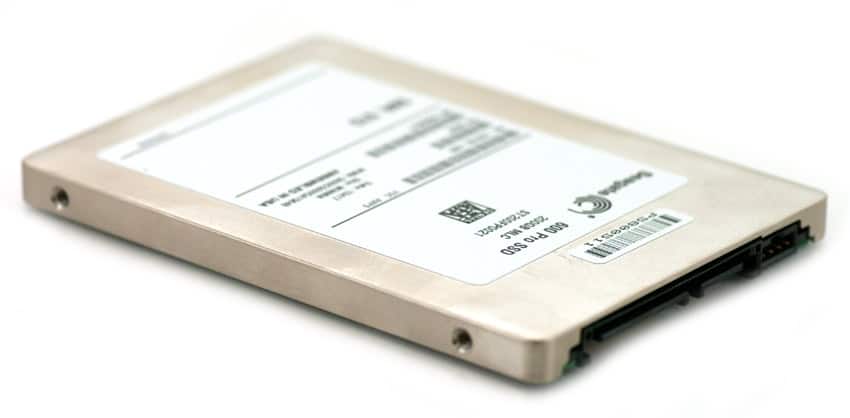
In line with SSD standard, the side profile presents the screw holes which enable simple mounting for a speedy installation. Also standard, on the front of the drive there are standard SATA power and data connectors.
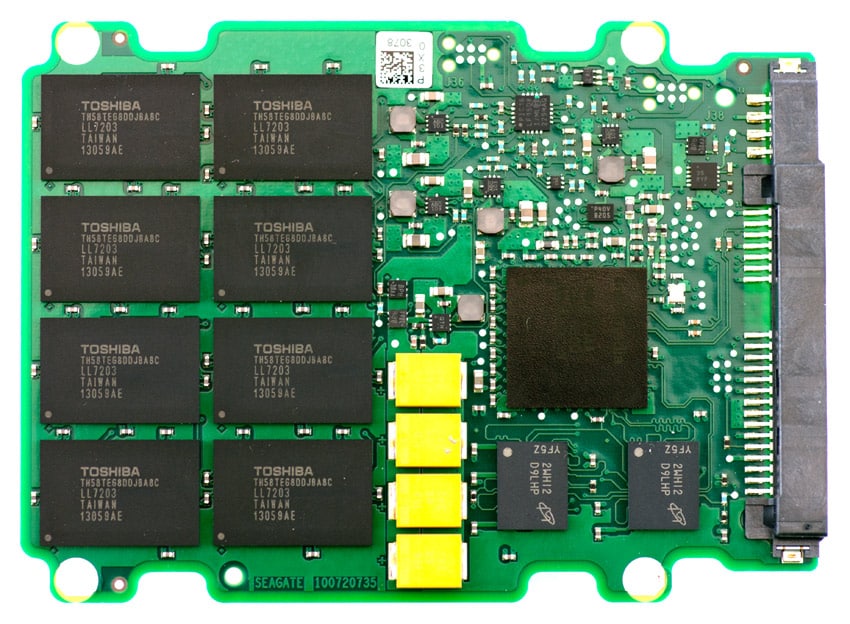
Over the life of the drive, disassembly is really unnecessary, but for reference, you can check out our Seagate 600 SSD client disassembly. Internally, the Seagate 600 Pro SSD uses the Link-a-Media LM87800 controller with Micron DRAM for buffering. It also uses Toshiba MLC NAND, and in our 200GB model, there are eight 32GB Toshiba TH58TEG8DDJBA8C NAND packages, over-provisioned at a 22% level. The 600 Pro also includes four 1500uf capacitors for power loss protection.
Testing Background and Comparables
The Seagate 600 Pro SSD uses Toshiba 19nm MLC NAND and a LAMD LM87800 controller with a SATA 6.0Gb/s interface.
Comparables for this review:
- Samsung SSD 840 Pro (512GB, 300mhz Samsung 3-core MCX controller, Samsung 2x nm Toggle NAND Flash, 6.0Gb/s SATA)
- Samsung SM843 (240GB, 300mhz Samsung 3-core MCX controller, Samsung 2x nm Toggle NAND Flash, 6.0Gb/s SATA)
- Intel SSD 520 (240GB, SandForce SF-2500 controller, Intel 25nm MLC NAND Flash, 6.0Gb/s SATA)
- Micron M500 (480GB, Marvell 9187, Micron 20nm MLC NAND Flash, SATA)
- Micron M500 (960GB, Marvell 9187, Micron 20nm MLC NAND Flash, SATA)
All SAS/SATA enterprise SSDs are benchmarked on our second-generation enterprise testing platform based on a Lenovo ThinkServer RD630. This new Linux-based testing platform includes the latest interconnect hardware such as the LSI 9207-8i HBA as well as I/O scheduling optimizations geared towards best-case flash performance. For synthetic benchmarks, we utilize FIO version 2.0.10 for Linux and version 2.0.12.2 for Windows.
- 2 x Intel Xeon E5-2620 (2.0GHz, 15MB Cache, 6-cores)
- Intel C602 Chipset
- Memory – 16GB (2 x 8GB) 1333Mhz DDR3 Registered RDIMMs
- Windows Server 2008 R2 SP1 64-bit, Windows Server 2012 Standard, CentOS 6.3 64-Bit
- 100GB Micron RealSSD P400e Boot SSD
- LSI 9211-4i SAS/SATA 6.0Gb/s HBA (For boot SSDs)
- LSI 9207-8i SAS/SATA 6.0Gb/s HBA (For benchmarking SSDs or HDDs)
- Mellanox ConnectX-3 10GbE PCIe 3.0 Adapter
- Mellanox ConnectX-3 InfiniBand PCIe 3.0 Adapter
Enterprise Synthetic Workload Analysis
Flash performance varies throughout the preconditioning phase of each storage device. Our enterprise storage benchmark process begins with an analysis of the way the drive performs during a thorough preconditioning phase. Each of the comparable drives are secure erased using the vendor’s tools, preconditioned into steady-state with the same workload the device will be tested with under a heavy load of 16 threads with an outstanding queue of 16 per thread, and then tested in set intervals in multiple thread/queue depth profiles to show performance under light and heavy usage.
Preconditioning and Primary Steady-State Tests:
- Throughput (Read+Write IOPS Aggregate)
- Average Latency (Read+Write Latency Averaged Together)
- Max Latency (Peak Read or Write Latency)
- Latency Standard Deviation (Read+Write Standard Deviation Averaged Together)
Our Enterprise Synthetic Workload Analysis includes four profiles based on real-world tasks. These profiles have been developed to make it easier to compare to our past benchmarks as well as widely-published values such as max 4K read and write speed and 8K 70/30, which is commonly used for enterprise drives. We also included two legacy mixed workloads, the traditional File Server and Webserver, each offering a wide mix of transfer sizes.
- 4K
- 100% Read or 100% Write
- 100% 4K
- 8K 70/30
- 70% Read, 30% Write
- 100% 8K
- File Server
- 80% Read, 20% Write
- 10% 512b, 5% 1k, 5% 2k, 60% 4k, 2% 8k, 4% 16k, 4% 32k, 10% 64k
- Webserver
- 100% Read
- 22% 512b, 15% 1k, 8% 2k, 23% 4k, 15% 8k, 2% 16k, 6% 32k, 7% 64k, 1% 128k, 1% 512k
Our first test measures 100% 4k random write performance with a load of 16T/16Q. The Seagate SSD Pro 200GB tested at 62,000 IOPS in burst, which quickly leveled off below some of the other drives. However, the Seagate 600 SSD Pro 200GB leveled off near the 30-32,000 IOPS range as it entered steady-state. This placed it significantly higher than the other SSDs.
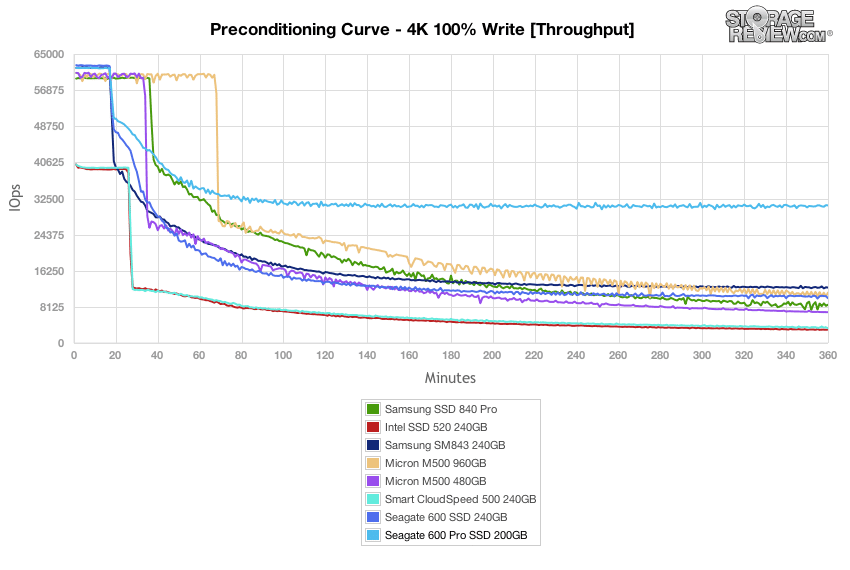
With a heavy 16T/16Q load, the Seagate 600 Pro SSD 200GB measured 4.13ms in burst and scaled up to 8.35ms as it neared steady-state. The Seagate 600 Pro SSD was again top of the pack with very low average latency.
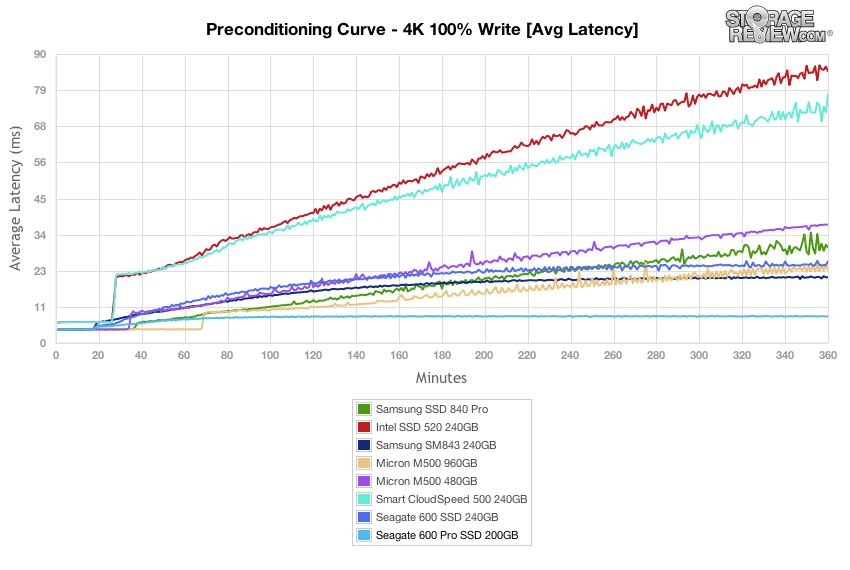
Comparing max latency between the SSDs, the Seagate 600 SSD Pro 200GB had max response times ranging between 120-140ms in steady-state, which was highly consistent and the best again.
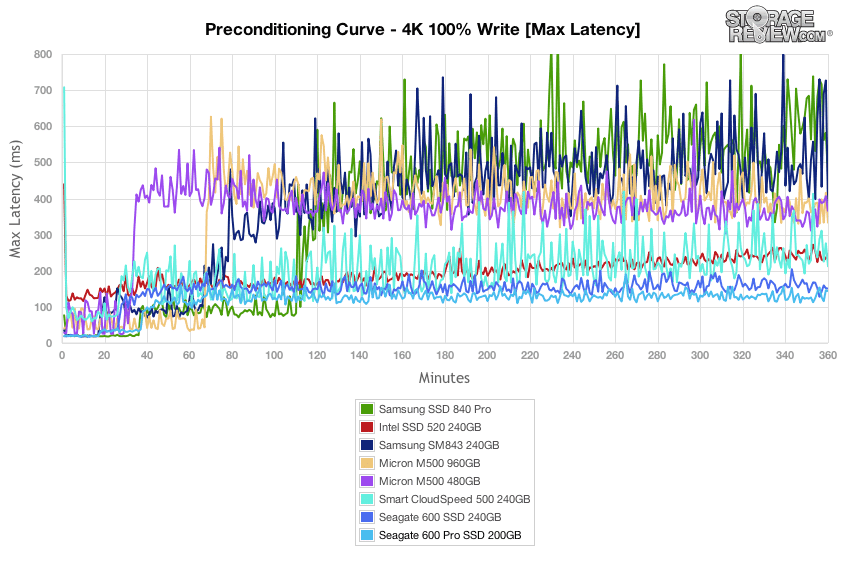
Looking even closer at the latency consistency in our 4k random write workload, the Seagate 600 Pro SSD was the leader of the group again.
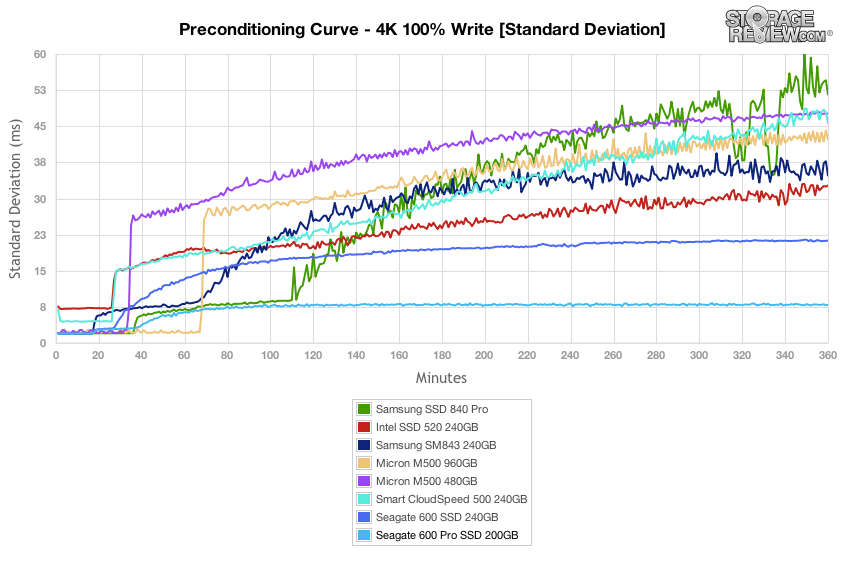
After 6 hours of preconditioning, the Seagate 600 Pro SSD 200GB offered higher-end 4k random read performance at 69,400 IOPS, and its write speed was handily the strongest at 30,600 IOPS.
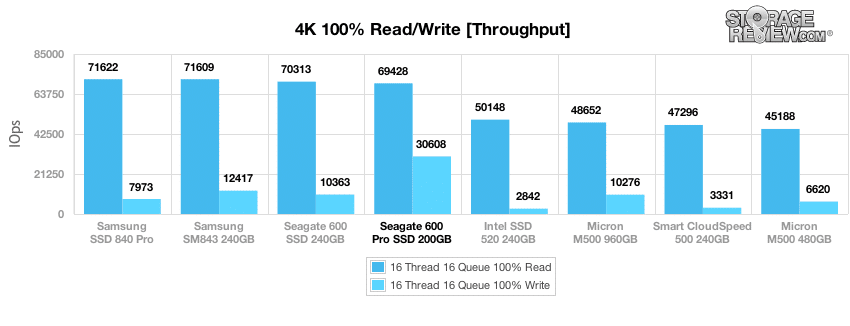
With a heavy load of 16T/16Q, the Seagate drive offered very low average read latency at 3.68ms, and it’s 4k average write latency was even better at 8.36ms.
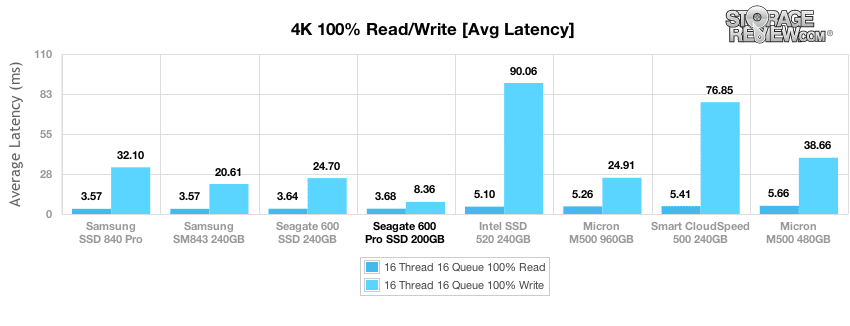
As we look at max latency in our 4k test, the Seagate 600 Pro SSD 200GB had excellent max read latency that was right on par with the Samsung drives at 21.82ms, and its write latency was the lowest amongst the group at just 188.09ms.
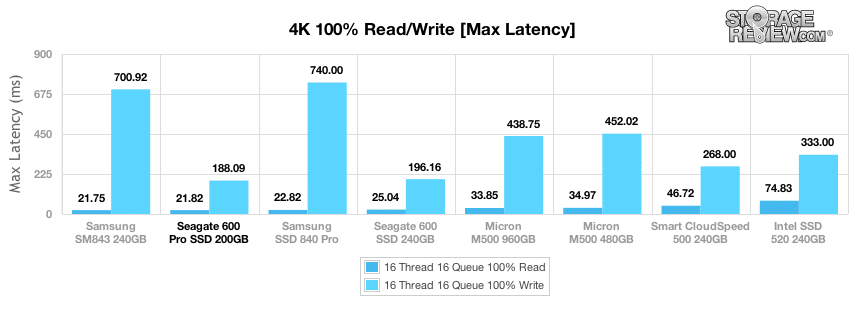
The Seagate 600 Pro SSD 200GB read latency standard deviation was again amongst the lowest by comparison, and the write latency at 8.03ms was the best.
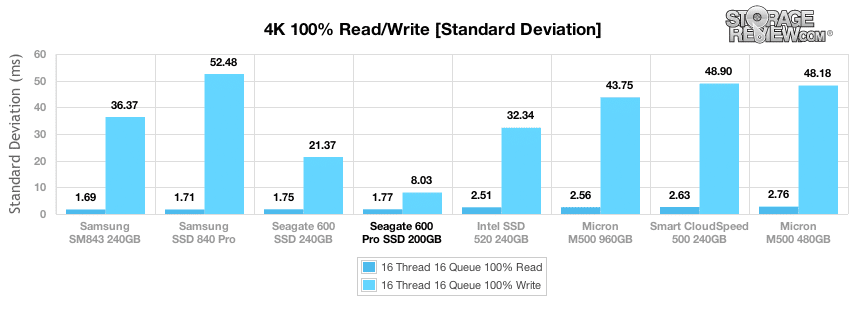
In our first mixed workload using an 8k profile 70/30% read/write spread and a constant 16T/16Q load, we measured a peak rate of 43,500 IOPS from the Seagate 600 Pro SSD 200GB before it hit steady-state at around 23,100 IOPS. The chart shows that the Micron M500 960GB stayed in burst the longest and offered great IOPS. Near the end of the curve at about 5-6 hours, the Seagate leapfrogged from second into first place in throughput.
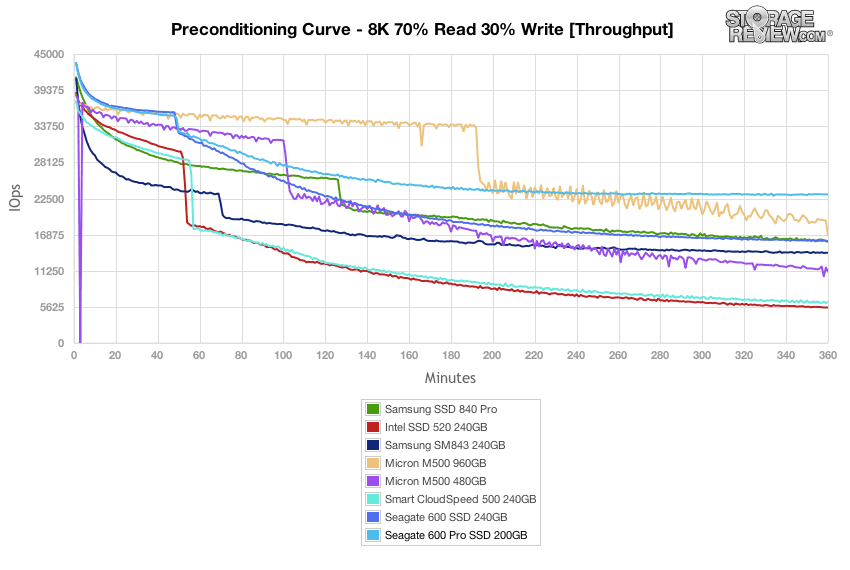
In our 8k 70/30 preconditioning workload the Seagate 600 Pro SSD scaled from about 6ms at burst to just below 12ms as it neared steady-state.
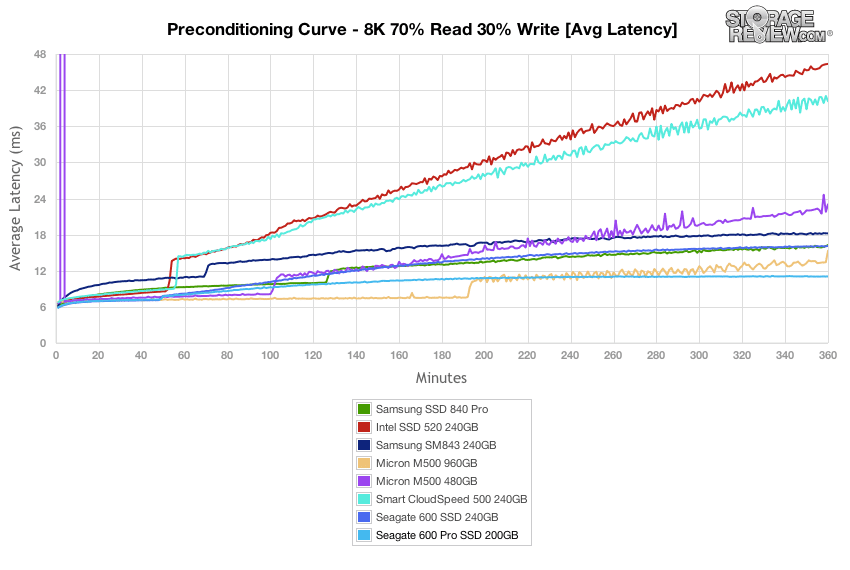
The additional over-provisioning on the 600 Pro SSD helped significantly compared to the other consumer-oriented SSDs, keeping peak response times in the 50ms band as the drive neared steady-state.
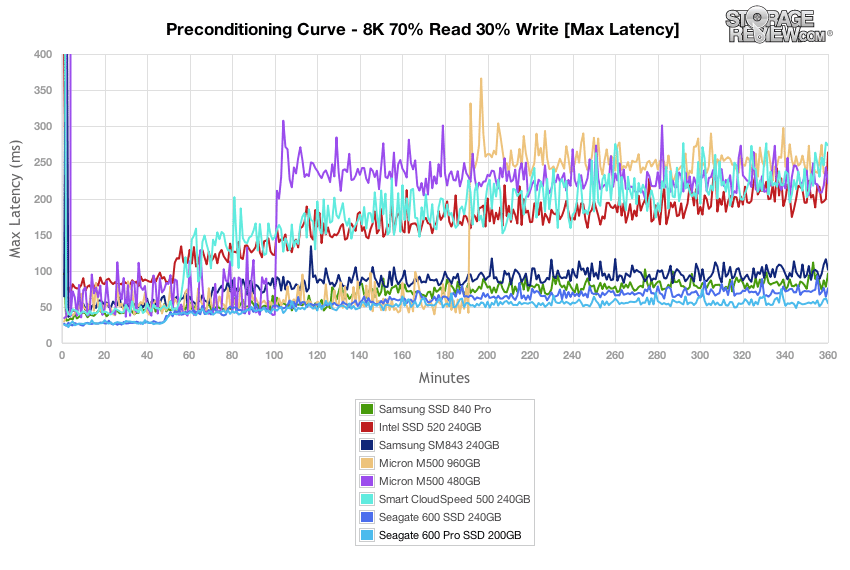
Diving into latency consistency, we noted exceptional latency standard deviation from the Seagate 600 Pro SSD, ranking top of class as the drive entered steady-state.
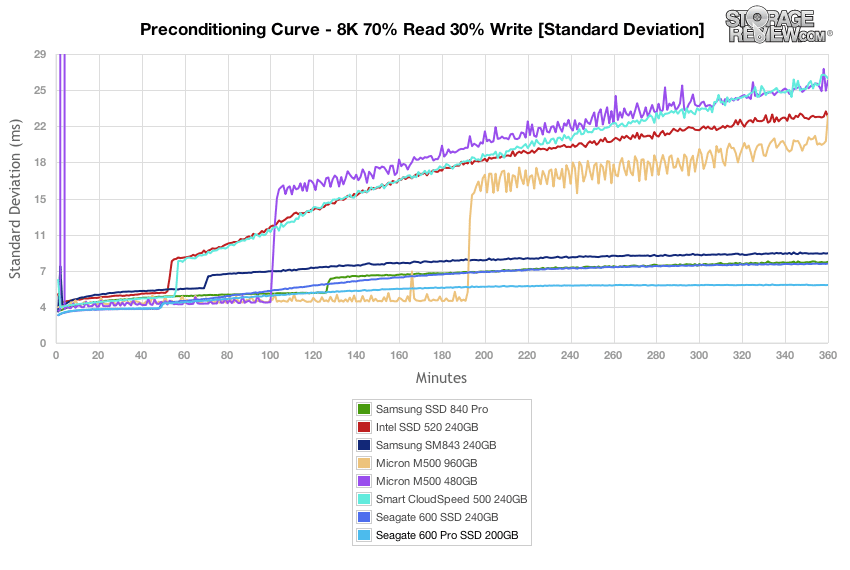
Compared to the fixed 16 thread 16 queue max workload we performed in the 100% 4k write test, our mixed workload profiles scale performance across a wide range of thread/queue combinations. In these tests, we span workload intensity from 2 threads and 2 queue up to 16 threads and 16 queue. In the expanded 8k 70/30 test, the Seagate 600 Pro SSD dominated the entry-enterprise group. Performance scaled from 13,262 IOPS at 2T/2Q up to 23,025 IOPS at 16T/16Q.
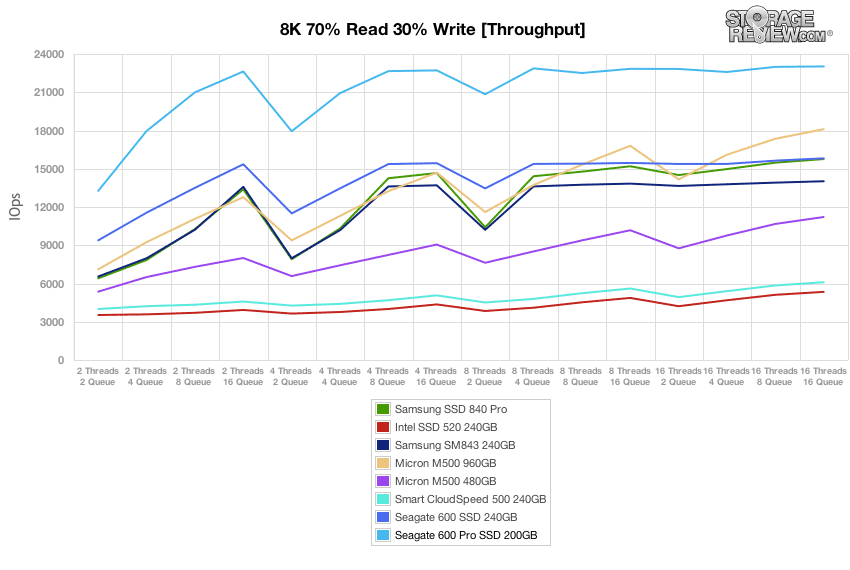
With the highest throughput, the Seagate 600 Pro SSD offered the lowest latency in the entry-enterprise group. Average latency ranged from 0.29ms at 2T/2Q up to 11.11ms at 16T/16Q.
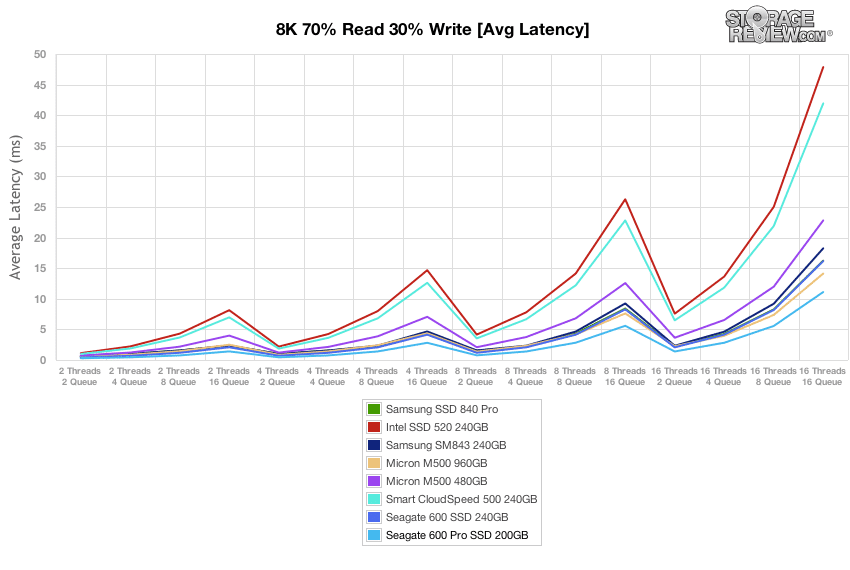
In our main 8k 70/30 test with each drive in steady-state, peak response times for loads under QD128 remained very low between 7-22ms.
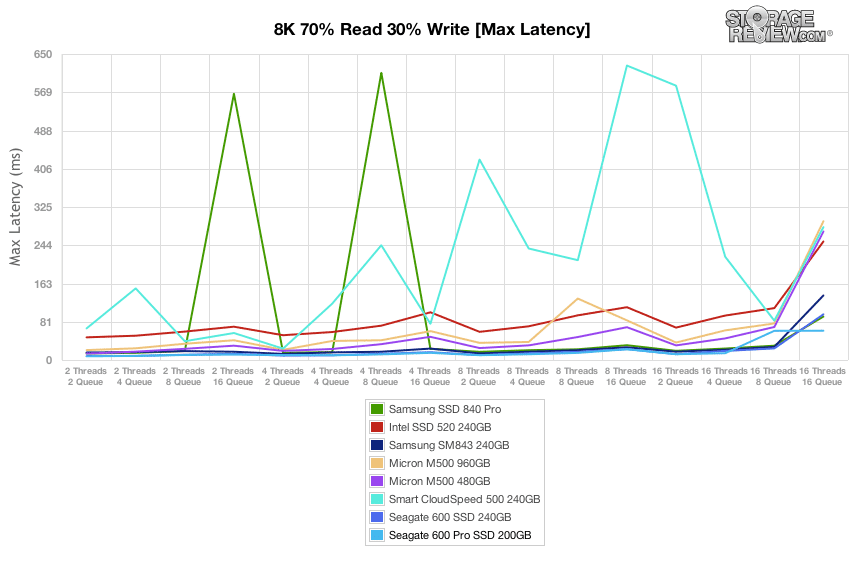
In terms of latency consistency in our 8k 70/30 workload, the Seagate 600 Pro SSD ranked top of class and offered an edge over the Samsung SM843.
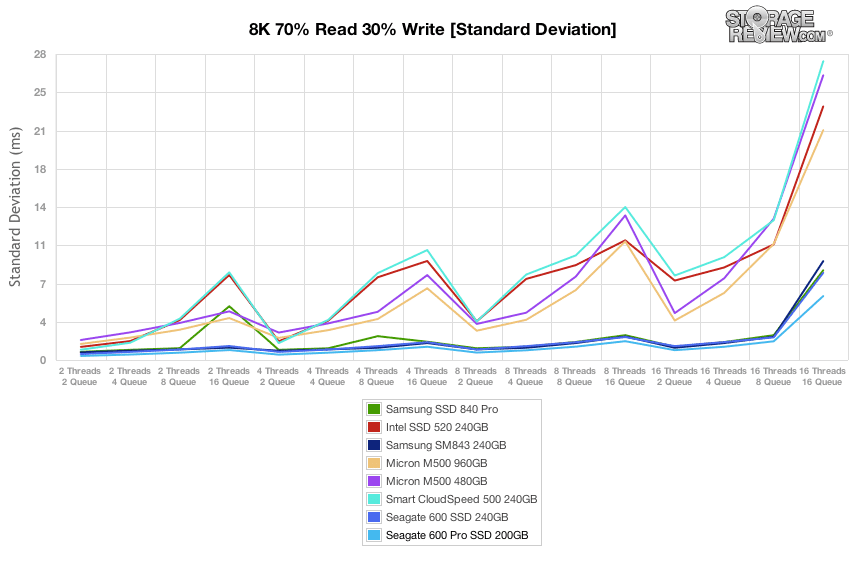
The next workload is our File Server profile, which covers a wide range of transfer sizes spanning from 512b to 512K. With a heavy 16T/16Q saturation load, the Seagate 600 Pro SSD ranged from 31,000 IOPS in burst to just under 15,000 IOPS in steady-state.
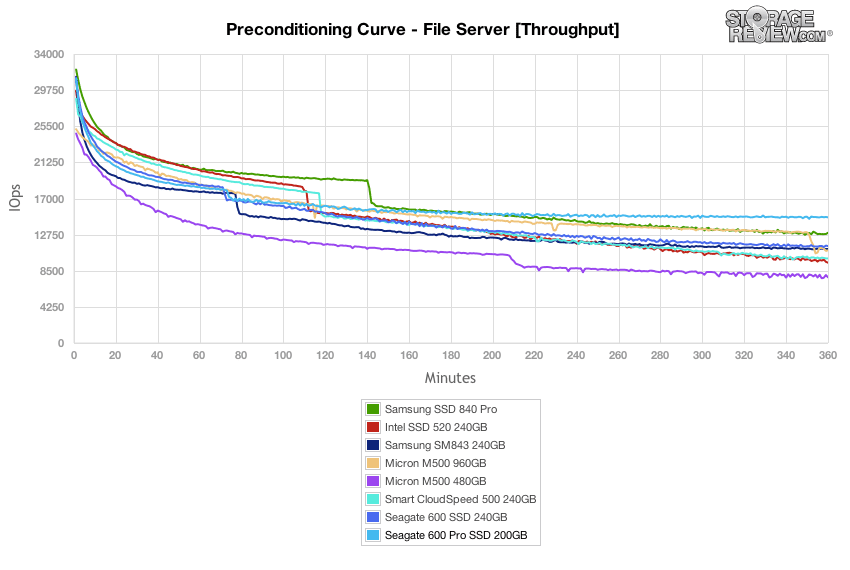
Comparing average latency in our File Server preconditioning test, the Seagate 600 Pro SSD scaled from 8ms in burst up to 17ms in steady-state.
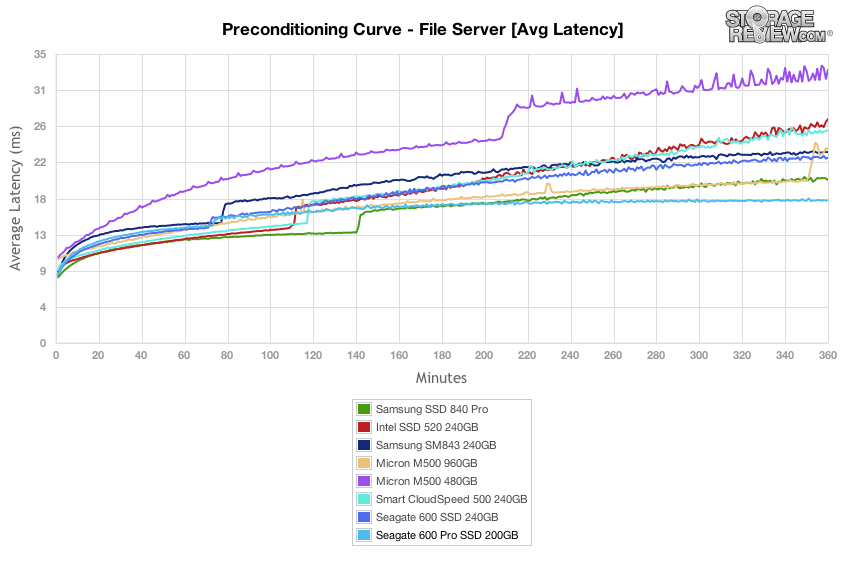
As the Seagate 600 Pro SSD neared steady-state in our File Server preconditioning test, max latency ranged between 110-150ms, on par with others in the group.
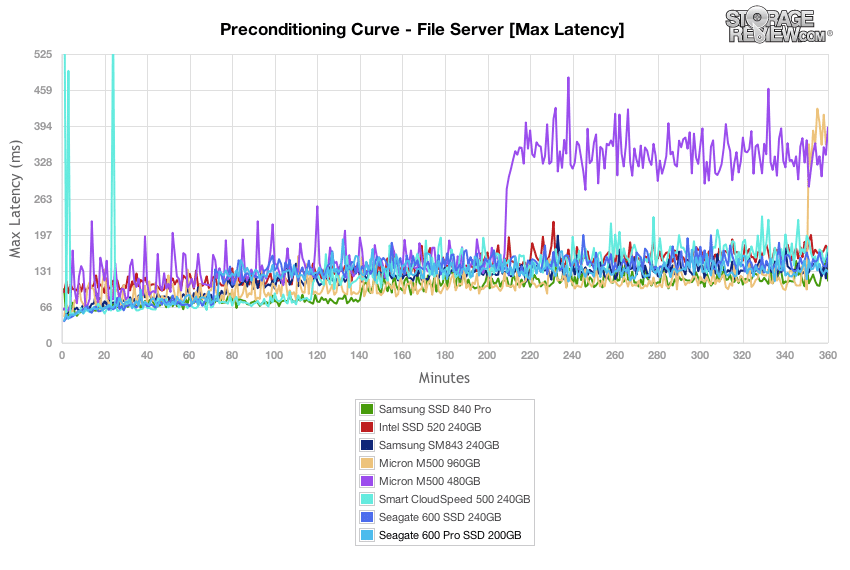
While peak latency from the Seagate 600 Pro SSD matched others in this class, switching focus to latency consistency, it offered top of class performance alongside the Samsung SSD 840 Pro.
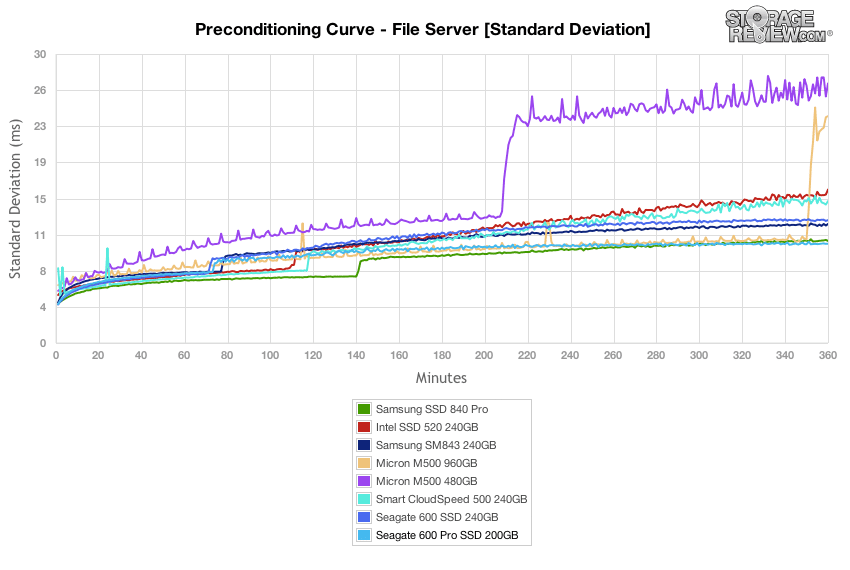
After our 6-hour File Server preconditioning process had finished on each SSD, we transitioned to varied workloads where we scale between 2T/2Q up to 16T/16Q. Similar to its strong performance in our 8k 70/30 workload, the Seagate 600 Pro offered an impressive lead against all other SSDs in this category. Performance scaled from 8,768 IOPS at 2T/2Q up to 14,790 IOPS at 16T/16Q.
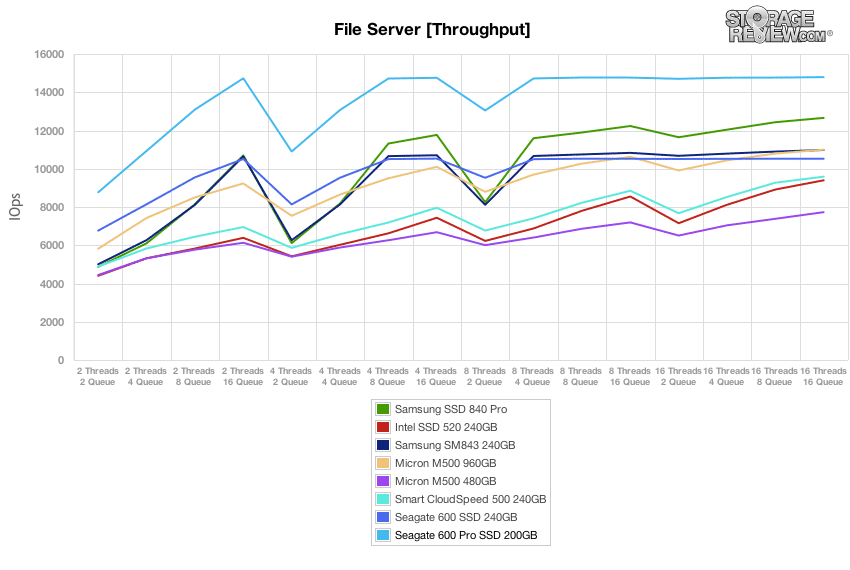
In our main File Server workload average latency ranked the lowest in the group, ranging from 0.45ms at 2T/2Q to 17.3ms at 16T/16Q.
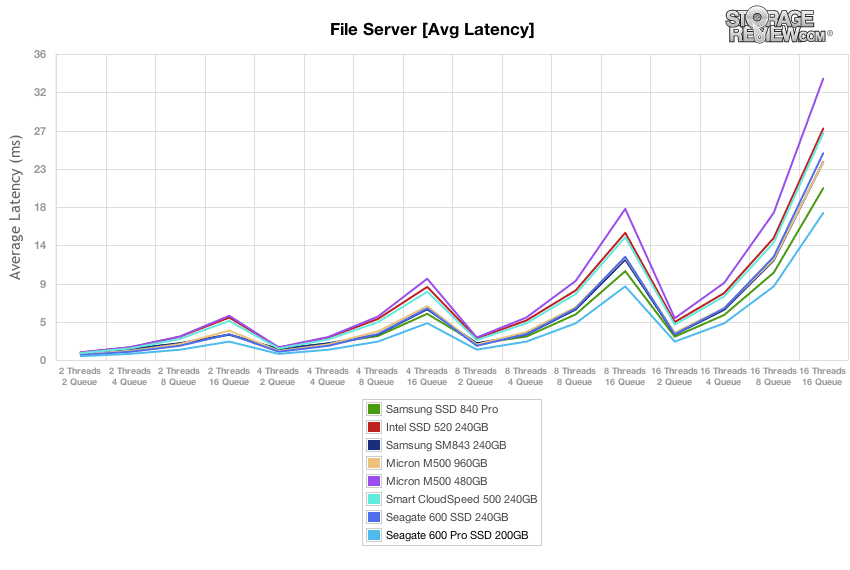
In our main File Server test, the Seagate 600 Pro SSD ranged from 9-33ms which ranked alongside the 600 SSD and Samsung SM843.
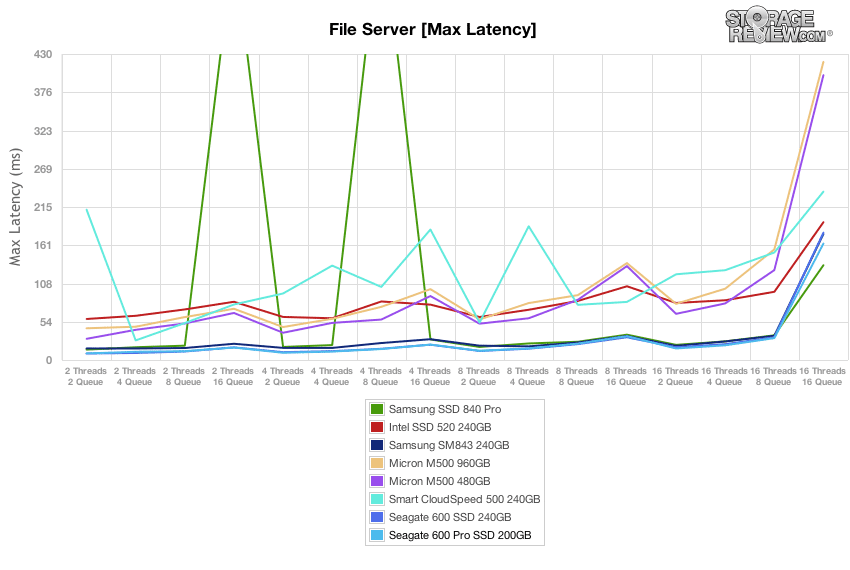
When it came to latency consistency in our main File Server test with each drive in steady-state, the Seagate 600 Pro SSD offered class-leading performance alongside the Samsung SM843.
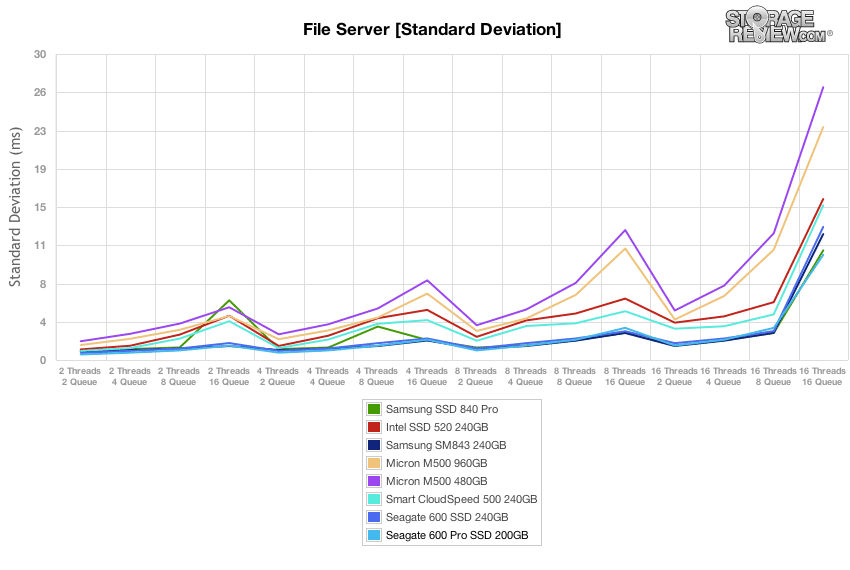
Our final preconditioning workload takes the traditional 100% read activity Web Server test and flips it to 100% write to precondition each SSD. This is our most aggressive workload, although it doesn’t really match any real-world conditions with 100% write. In this section, the Seagate 600 Pro SSD with its heavier over-provisioning lead the pack, offering nearly twice the 100% write performance.
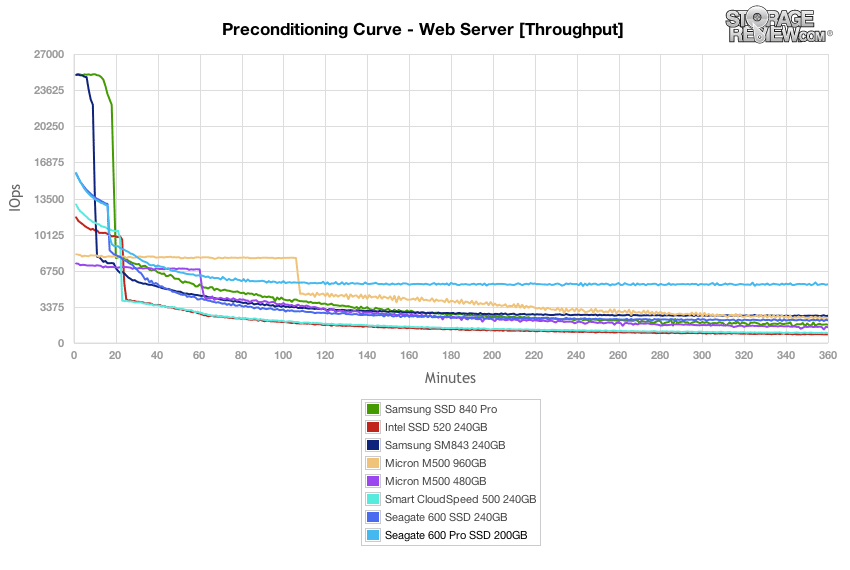
Comparing average latency in the preconditioning segment of our Web Server test, the Seagate 600 Pro SSD scaled from 16 to 46ms as it transitioned from burst to steady-state, fairing much better than other drives in this category.
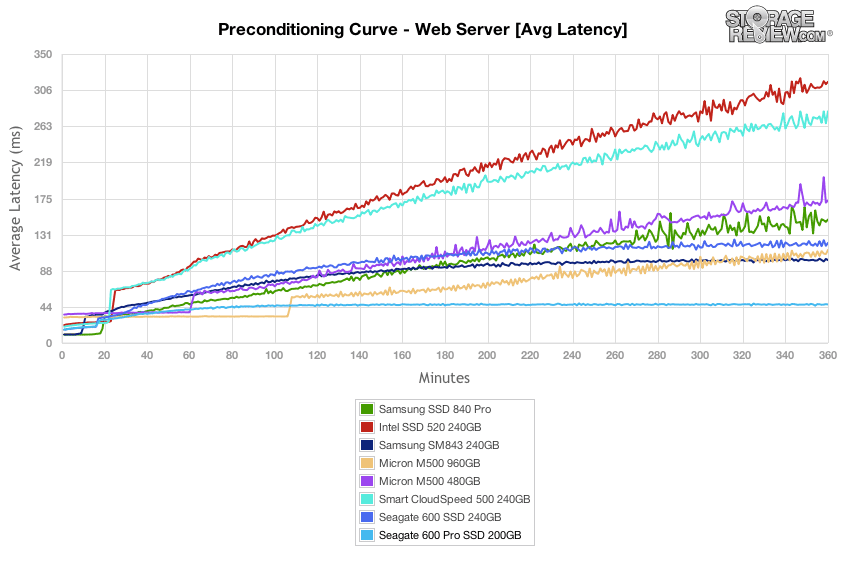
With its heavy over-provisioning, the LAMD-based 600 Pro SSD had max latency falling between 300-350ms, which was the lowest in the group, trailed by the nominally over-provisioned 600 SSD.
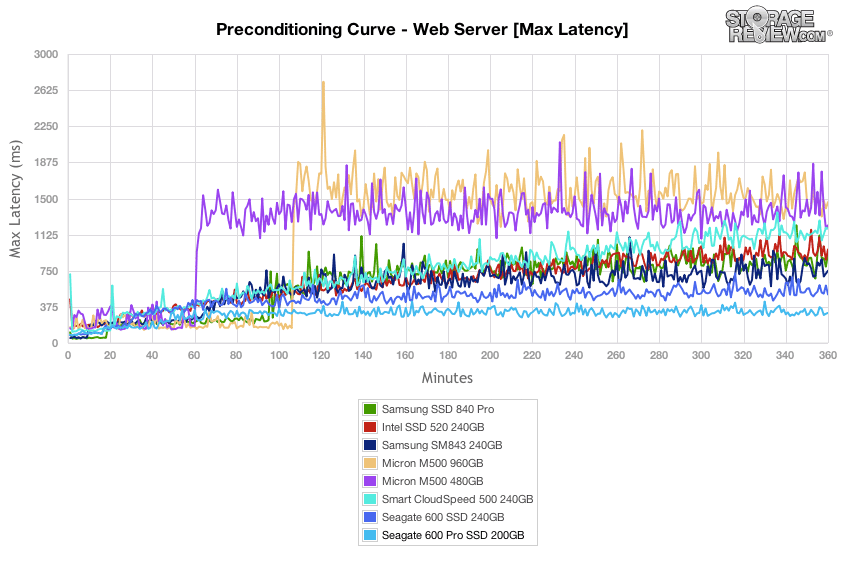
Switching our focus to latency consistency, the Seagate 600 Pro SSD offered dramatically lower standard deviation than competing models, with the Samsung SM843 as the next closest SSD.
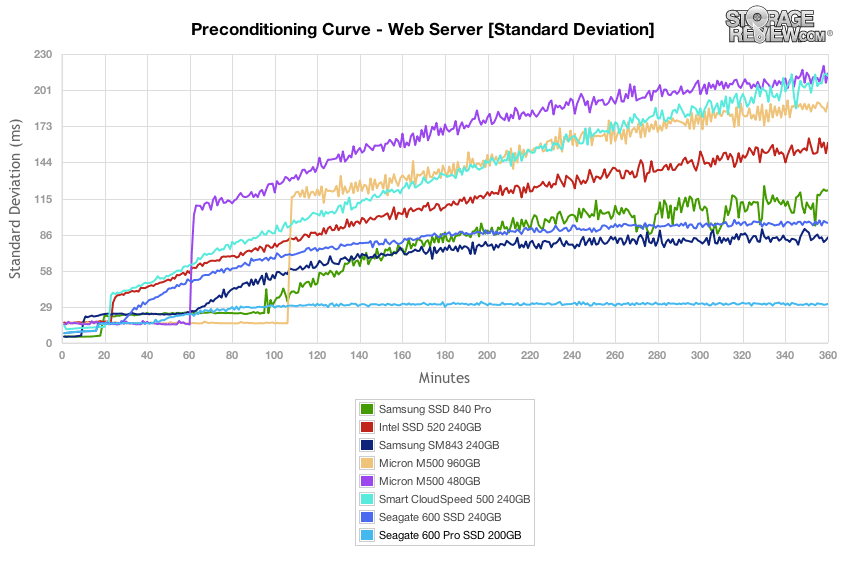
After each SSD finished our preconditioning stage in the Web Server test, we flipped the workload back to 100% read. In read-only conditions the Seagate 600 Pro SSD ranked upper middle of the pack behind the Samsung SM843 and SSD 840 Pro. Transfer performance ranged from 11,239 IOPS at 2T/2Q scaling to 23,409 IOPS at 16T/16Q.
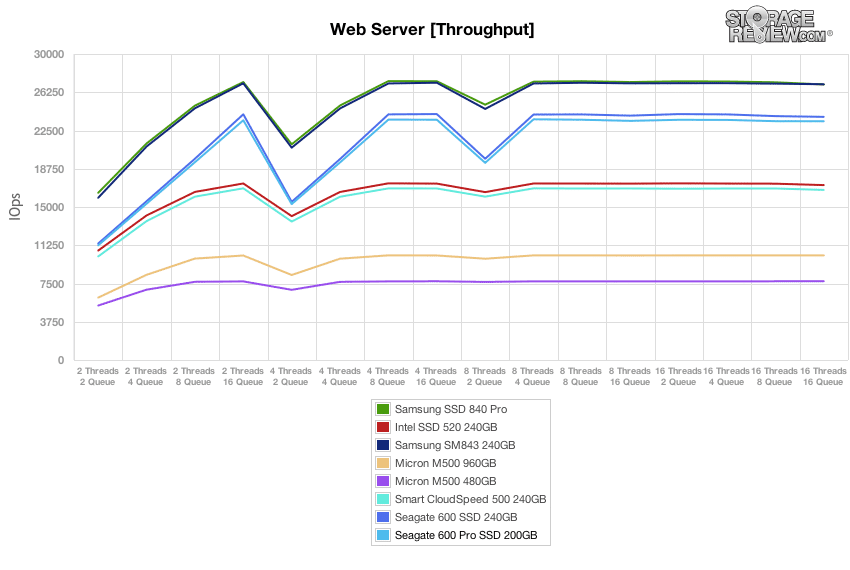
While not the fastest in the pack in our Web Server profile, the Seagate 600 Pro SSD still offered exceptionally low latency ranging from 0.352ms at 2T/2Q to 10.93ms at 16T/16Q.
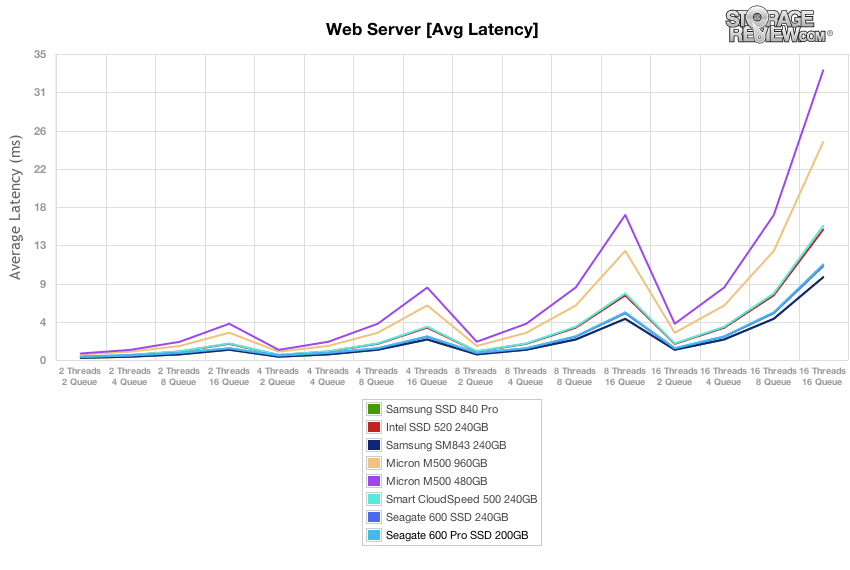
In our read-only Web Server test, max latency stayed very low for workloads under QD256, measuring under 15ms.
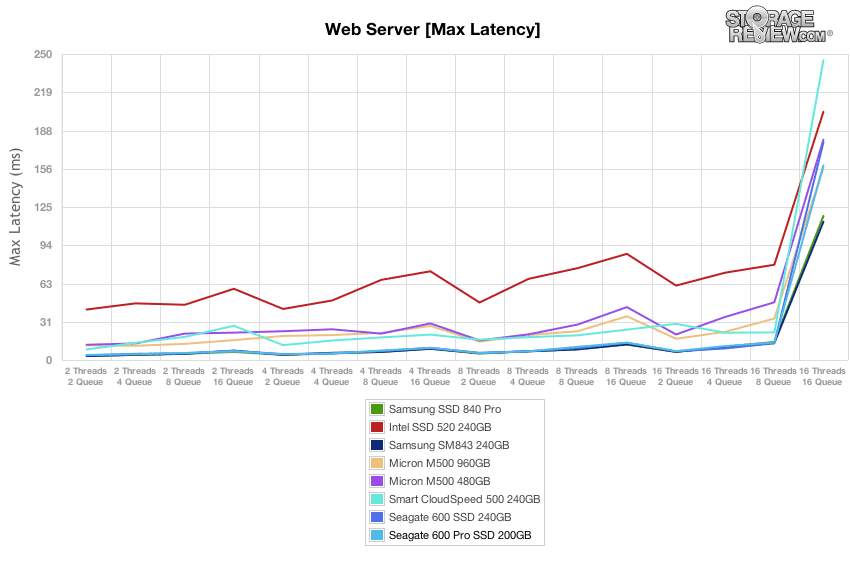
The Seagate 600 Pro SSD offered similar tight latency consistency to the Samsung SM843 in our Web Server test.
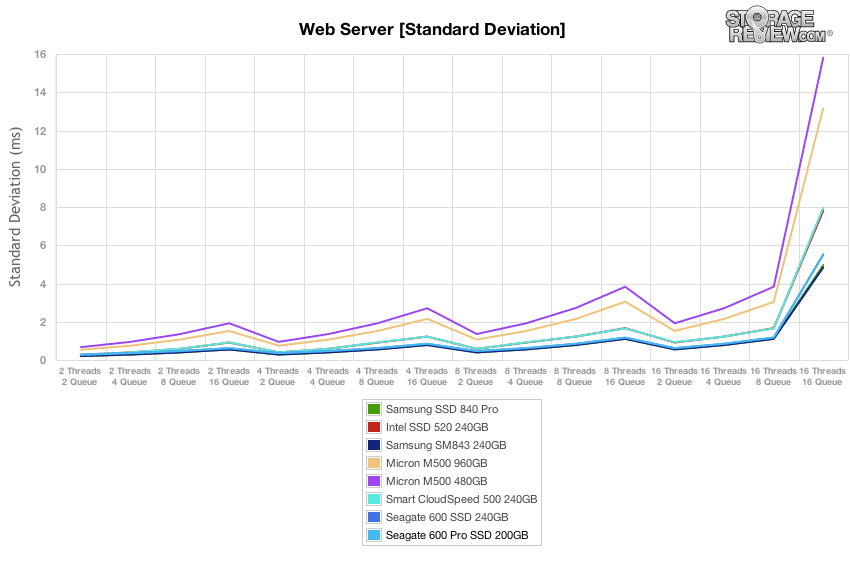
Conclusion
Seagate’s goal with their new entry-enterprise SSD was to design a drive to meet organizations’ needs for far greater endurance than client SSDs, offer at a pricing tier much more affordable than other enterprise SSDs on the market, and include features such as power-fail protection to maintain data integrity in demanding conditions. With that challenge in mind, Seagate designed the 600 Pro SSD as a 2.5-inch MLC NAND enterprise-class SSD powered by the Link-a-Media LM87800 controller. Seagate also delivers a range of over-provisioning options to meet a range of workloads by offering models with either 6% or 22% OP to handle read-heavy or more mixed conditions.
With our primary focus on the 200GB capacity Seagate 600 Pro SSD, we found it to offer surprisingly exceptional performance in our write-heavy workloads compared to other entry-enterprise SSDs. In our 4k, 8k 70/30, and File Server workloads it dominated the group by offering the throughput we’d normally find from a mainstream enterprise SATA SSD. Its high I/O speeds weren’t the only advantage either, as it proved itself with very low peak latency and incredibly tight latency consistency. All of these traits are those you’d fine if you stepped up one price category, with one exception; endurance. The 400GB 600 Pro SSD tops out at 1PB of endurance, while SSDs like the Micron P400m offer up to 7PB for the same capacity. Endurance is one of the main price differentiators in this category; it’s great to see tiered options available for organizations that don’t need the higher level of endurance.
Overall the Seagate 600 Pro SSD enters the entry-enterprise market with a variety of capacity and endurance options and even packs in very good performance in heavier write conditions. The 600 Pro also includes features such as power-fail protection that isn’t found in many competing models in this price range.
Pros
- Class-leading write performance
- Exceptionally low peak latency and tight latency consistency
- 7mm z-height for wide array of applications
Cons
- Read performance slightly under Samsung SM843
Bottom Line
The Seagate 600 Pro SSD is a class-leading entry-enterprise model with a relatively low price-point targeted at organizations that require enterprise features for read-intensive data center and cloud applications not found in client drives.




 Amazon
Amazon